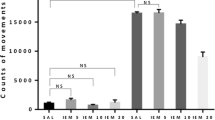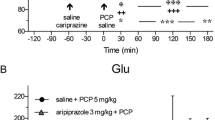Summary
The effects of a psychotomimetic drug, phencyclidine (PCP), on glutamatergic neurotransmission were studied in mice. The binding of tritiated N-[1-(2-thienyl)cyclohexyl]piperidine (TCP) to cerebral cortical membranes and the uptake of [3H]glutamate by cortical synaptosomal preparations were assessed after PCP treatment (1 mg/d/mouse for 3 days) with implanted minipumps. The binding capacity Bmax of TCP significantly increased but the binding constant KD remained the same after PCP exposure, indicating that more binding sites became available. The basic properties of the binding remained unaltered but the actions of glutamate, glutamate receptor agonists and glycine were potentiated in PCP-treated mice. The uptake of glutamate was saturable, consisting of both high- and low-affinity transport components. After PCP exposure the transport constant Km of the high-affinity component increased and that of the low-affinity component was not changed. The maximal velocity V of the high-affinity component increased while that of the low-affinity transport decreased. Moreover, inhibition by structural analogues was potentiated, suggesting modification of the glutamate transporter. The results show that chronic PCP treatment, used as a model of psychosis, markedly affects the studied glutamatergic parameters.
Similar content being viewed by others
References
Ali SF, Ahmad G, Slikker W, Bondy SC (1988) Gestational exposure to phencyclidine (PCP) in rats decreases PCP binding sites in term fetal brain. Int J Dev Neurosci 6: 547–552
Anis NA, Berry SC, Burton NR, Lodge D (1983) The dissociative anaesthetics, ketamine and phencyclidine, selectively reduce excitation of central mammalian neurons by N-methyl-aspartate. Br J Pharmacol 790: 565–575
Bonhaus DW, Burge BC, McNamara JO (1987) Biochemical evidence that glycine allosterically regulates an NMDA receptor-coupled ion channel. Eur J Pharmacol 142: 489–490
Contreras PC, Rice KC, Jacobson AE, O'Donohue TL (1986) Stereotyped behavior correlates better than ataxia with phencyclidine receptor interactions. Eur J Pharmacol 121: 9–18
Danysz W, Wroblewski JT, Brooker G, Costa E (1989) Modulation of glutamate receptors by phencyclidine and glycine in the rat cerebellum: cGMP increase in vivo. Brain Res 479: 270–276
Domino EF, Luby ED (1981) Abnormal mental states induced by phencyclidine as a model of schizophrenia. In: Domino EF (ed) PCP (Phencyclidine): historical and current perspectives. NPP Books, Ann Arbor, pp 410–418
Drejer J, Larsson OM, Schousboe A (1982) Characterization of L-glutamate uptake into and release from astrocytes and neurons cultured from different brain regions. Exp Brain Res 47: 259–269
Fagg GE (1987) Phencyclidine and related drugs bind to the activated N-methyl-D-aspartate receptor-channel complex in rat brain membranes. Neurosci Lett 76: 221–227
Fagg GE, Foster AC, Ganong AH (1986) Excitatory amino acid synaptic mechanisms and neurological function. Trends Pharmacol Sci 7: 357–363
Fauman MA, Fauman BJ (1981) Chronic phencyclidine (PCP) abuse: a psychiatric perspective. In: Domino EF (ed) PCP (Phencyclidine): historical and current perspectives. NPP Books, Ann Arbor, pp 207–242
Flint BA, Ho IK (1980) Tolerance development to phencyclidine by chronic administration. Prog Neuropsychopharmacol 4: 233–239
Fonnum F (1984) Glutamate: a neurotransmitter in mammalian brain. J Neurochem 42: 1–11
Foster AC, Wong EHF (1987) The novel anticonvulsant MK-801 binds to the activated state of the N-methyl-D-aspartate receptor in rat brain. Br J Pharmacol 91: 304–309
Garey RE, Heath RG (1976) The effects of phencyclidine on the uptake of3H-catecholamines by rat striatal and hypothalamic synaptosomes. Life Sci 18: 1105–1110
Harrison PJ, McLaughlin D, Kerwin RW (1991) Decreased hippocampal expression of a glutamate receptor gene in schizophrenia. Lancet 337: 450–452
Hood WF, Compton RP, Monahan JB (1989) D-Cycloserine: a ligand for the N-methyl-D-aspartate coupled glycine receptor has partial agonist characteristics. Neurosci Lett 98: 91–95
Johnson JW, Ascher P (1987) Glycine potentiates the NMDA response in cultured mouse brain neurons. Nature 325: 529–531
Johnson KM (1983) Phencyclidine: behavioral and biochemical evidence supporting a role of dopamine. Fed Proc 42: 2579–2583
Johnson KM, Snell LD (1985) Effects of phencyclidine (PCP)-like drugs on turning behavior,3H-dopamine uptake, and3H-PCP binding. Pharmacol Biochem Behav 22: 731–735
Kessler M, Terramani T, Lynch G, Baudry M (1989) A glycine site associated with N-methyl-D-aspartic acid receptors: characterization and identification of a new class of antagonists. J Neurochem 52: 1319–1328
Kim JS, Kornhuber HH, Schmid-Burgk W, Holzmüller B (1980) Low cerebrospinal fluid glutamate in schizophrenic patients and a new hypothesis on schizophrenia. Neurosci Lett 20: 379–382
Kloog Y, Haring R, Sokolovsky M (1988) Kinetic characterization of the phencyclidine-N-methyl-D-aspartate receptor interaction: evidence for a steric blockade of the channel. Biochemistry 27: 843–848
Kloog Y, Lamdani-Itkin H, Sokolovsky M (1990) The glycine site of the N-methyl-D-aspartate receptor channel: differences between the binding of HA-966 and of 7-chlorokynurenic acid. J Neurochem 54: 1576–1583
Kontro P (1984) Comparison of taurine, hypotaurine, and β-alanine uptake in brain synaptosomal preparations from developing and adult mouse. Int J Dev Neurosci 2: 465–470
Kontro P, Oja SS (1987) Glycinergic systems in brain stem of developing and adult mice: effects of taurine. Int J Dev Neurosci 5: 461–470
Lanthorn TH, Hood WF, Watson GB, Compton RP, Rader RK, Gaoni Y, Monahan JB (1990) cis-2,4-Methanoglutamate is a potent and selective N-methyl-D-aspartate receptor agonist. Eur J Pharmacol 182: 397–404
Leelavathi DE, Misra CH, Shelat H, Smith RC (1980) Effects of acute and chronic administration of phencyclidine on dopaminergic receptors in rat striatum. Commun Psychopharmacol 4: 417–424
Lillrank SM, Oja SS, Seppälä T, Saransaari P (1992) Phencyclidine treatments differentially affect dopamine and D-aspartate release from frontal cortical and striatal slices from mice. Int J Neurosci 64: 69–81
Loo P, Braunwalder A, Lehmann J, Williams M (1986) Radioligand binding to central phencyclidine recognition sites is dependent on excitatory amino acid receptor agonists. Eur J Pharmacol 123: 467–468
Loo PS, Braunwalder AF, Lehmann J, Williams M, Sills MA (1988) Interaction of L-glutamate and magnesium with phencyclidine recognition sites in rat brain: evidence for multiple affinity states of the phencyclidine/N-methyl-D-aspartate receptor complex. Mol Pharmacol 32: 820–830
Lowry OH, Rosebrough NJ, Farr AL, Randall RJ (1951) Protein measurement with the Folin phenol reagent. J Biol Chem 193: 265–275
Meltzer HY, Sturgeon RD, Simonovic M, Fessler RG (1981) Phencyclidine as an indirect dopamine agonist. In: Domino EF (ed) PCP (Phencyclidine): historical and current perspectives. NPP Books, Ann Arbor, pp 207–242
Nabeshima T, Sivam SP, Tai CY, Ho IK (1982) Development of dispositional tolerance to phencyclidine by osmotic minipump in the mouse. J Pharmacol Meth 7: 239–253
Nelder JA, Mead R (1965) A simplex method for function minimization. Computer J 7: 308–313
Robinson MB, Hunter-Ensor M, Sinor J (1991) Pharmacologically distinct sodium-dependent L-[3H]glutamate transport processes in rat brain. Brain Res 544: 196–202
Saransaari P, Oja SS (1992) Release of D-aspartate from cerebral cortex slices from developing and adult mice. Mol Neuropharmacol 2: 189–191
Sherman AD, Davidson AT, Baruah S, Hegwood TS, Waziri R (1991) Evidence of glutamatergic deficiency in schizophrenia. Neurosci Lett 121: 77–80
Smith RC, Meltzer Y, Arora RC, Davis JM (1977) Effects of phyencyclidine on [3H]catecholamine and [3H] serotonin uptake in synaptosomal preparations from rat brain. Biochem Pharmacol 26: 1435–1439
Smith RC, Taylor D, Ho BT, Leelavathi DE (1980) Effects of acute and chronic administration of phencyclidine on tyrosine hydroxylase activity in rat striatum. J Neural Transm 48: 289–295
Snell LD, Morter RS, Johnson KM (1987) Glycine potentiates N-methyl-D-aspartateinduced [3H]TCP binding to rat cortical membranes. Neurosci Lett 83: 313–317
Stirling JM, Cross AJ, Green AR (1989) The binding of [3H]thienyl cyclohexylpiperidine ([3H]TCP) to the NMDA-phencyclidine receptors complex. Neuropharmacology 28: 1–7
Thomas JW, Hood WF, Monahan JB, Contreras PC, O'Donohue TL (1988) Glycine modulation of the phencyclidine binding site in mammalian brain. Brain Res 442: 396–398
Varga V, Marnela K-M, Kontro P, Gulyás J, Vadász Z, Lähdesmäki P, Oja SS (1987) Effects of acidic dipeptides on aminoacidergic neurotransmission in the brain. In: Huxtable RJ, Franconi F, Giotti A (eds) The biology of taurine. Methods and mechanisms. Plenum Press, New York, pp 357–368
Vignon J, Chicheportiche R, Chicheportiche M, Kamenka J-M, Geneste P, Lazdunski M (1983) [3H]TCP: a new tool with high affinity for the PCP receptor in rat brain. Brain Res 280: 194–197
Ward D, Trevor A (1981) Phencyclidine-induced alteration in rat muscarinic cholinergic receptor regulation. Eur J Pharmacol 74: 189–193
Watkins JC, Krogsgaard-Larsen P, Honoré T (1990) Structure-activity relationships in the development of excitatory amino acid receptor agonists and competitive antagonists. Trends Pharmacol Sci 11: 25–33
Zukin SR, Fritz-Syage ML, Nichtenhauser R, Zukin S (1983) Specific binding of [3H]phencyclidine in rat central nervous tissue: further characterization and technical considerations. Brain Res 258: 277–284
Author information
Authors and Affiliations
Rights and permissions
About this article
Cite this article
Saransaari, P., Lillrank, S.M. & Oja, S.S. Phencyclidine treatment in mice: Effects on phencyclidine binding sites and glutamate uptake in cerebral cortex preparations. J. Neural Transmission 93, 47–59 (1993). https://doi.org/10.1007/BF01244937
Received:
Accepted:
Issue Date:
DOI: https://doi.org/10.1007/BF01244937




